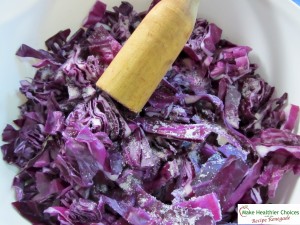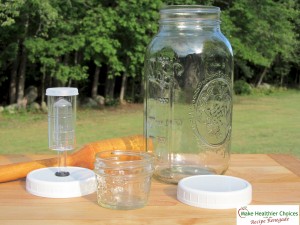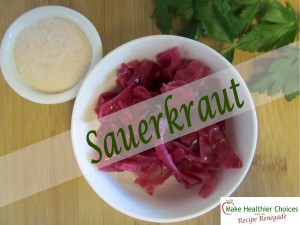Fermenting was a lost art that is making a comeback. Although it was intimidating when I first tried fermenting, I quickly learned how easy it is. What a great, inexpensive way to populate the gut with probiotics (good bacteria and yeast). Sauerkraut fermenting is an anaerobic (without oxygen) process as opposed to Kombucha and Milk Kefir which are aerobic (with oxygen) processes.
With any fermentation process, it is important to keep out pathogens. I typically use a paper towel or dishcloth with a rubber band around the jar for aerobic ferments and an airlock for anaerobic ferments. The airlock allows gases to escape and does not allow pathogens into the ferment. If not using an airlock for anaerobic ferments, yeasts and molds can easily enter the ferment. Personally, I’d rather not have to worry about figuring out if that weird growth on top is a safe-to-eat yeast or a dangerous mold. If a dangerous mold grows on top, the entire ferment needs to find its way to the garbage. For the low price of an airlock today, I’d rather play it safe! 
If you don’t have time to make your own, try this one from Amazon: Organic Hamptons Brine Artisinal Sauerkraut Classic
I adapted this recipe from Nourishing Traditions cookbook by Sally Fallon and Mary Enig.
- 1 Tablespoon Celtic Salt or Himalayan Salt
- ¼ Cup Liquid Whey (strained from yogurt or cheese NOT powder)
- Cored and Shredded Small Cabbage
- Water (without chlorine or fluoride)
- Remove outer leaves of cabbage and set aside.
- Shred cabbage and place in large plastic bowl.
- Sprinkle salt over cabbage.
- Using a wooden pounder (tamper, stomper), pound cabbage. (A mallet-type meat tenderizer will also work for this step.)
- Let sit for one hour to release juices.
- Tightly stuff cabbage and juice into 2-quart mason jar, using pounder to tamp down.
- Cover with saved cabbage leaf.
- Add liquid whey.
- Add un-chlorinated, un-fluoridated water to within a few inches of the top.
- Add weight.
- Fill with clean un-chlorinated, un-fluoridated water leaving one inch of air space on top.
- Cover with lid that has airlock.
- Sit on counter top (place towel or tray underneath in case it leaks) and allow to ferment for 4 days.
- Store in refrigerator.
- NOTE: If whey is not available, add 1 extra tablespoon of salt. DO NOT USE POWDERED WHEY!
Along with the whey, salt, cabbage, and water, supplies I like to use for fermenting are: pounder, large plastic bowl, glass (non-lead) vessel(s) to hold about 2 quarts cabbage (about one head of cabbage), a weight to hold the cabbage down under the water, and airlock lid. Patience is required—4 days is minimum, and it’s said to be best after storing in refrigerator for 6 months.
The only items I recall my mom using for fermenting when I was a kid were a crock, a plate, and a clean rock for holding the plate/cabbage under the water. She also fermented in the basement, which I’m sure probably contained lots of mold. There are some molds that are okay and can be skimmed off and other molds that require the entire ferment be thrown out. Honestly, I’d rather not need to learn the difference—I’d rather simply use an airlock. It’s not necessary, but I sure feel better using one. (If you’re a do-it-your-self type, it’s possible to add an airlock to most any plastic or metal lid.) Scroll down below the recipe to see my supplies.
I find it’s easier to shred the cabbage cutting it into strips with a sharp knife rather than a food processor.
I don’t remember where my first recipe came from, but I couldn’t eat it. The recipe didn’t use whey, so the salt was doubled. It also called for juniper berries. I’m not a fan of anything juniper (I should have known to leave them out) and I love salt, but the sauerkraut turned out way too salty! When less salt is used, because whey is substituted, it’s much more palatable in my humble opinion.
Below are my fermenting supplies. I place the small jar (right side up) on top of the cabbage leaf to help keep the cabbage under the water. The solid cover is for after the cabbage becomes sauerkraut:
 If liquid whey from home-made yogurt is not available, it is possible to use store-bought yogurt. Unfortunately, there’s no guarantee there will be live cultures in *commercial yogurt. If possible, find someone who makes yogurt or cheese and beg for liquid whey!
If liquid whey from home-made yogurt is not available, it is possible to use store-bought yogurt. Unfortunately, there’s no guarantee there will be live cultures in *commercial yogurt. If possible, find someone who makes yogurt or cheese and beg for liquid whey!
*According to world-renowned food formulator, Russ Bianchi’s January 12, 2013 blog post, “Yogurt is complete JUNK FOOD, full of harmful acids, sugars, fake color and flavors, genetically modified starches, colloids, gums, preservatives, stabilizers, emulsifiers, with non-absorbable nutrients or fortification because it is cooked to at least 238 degrees F for a dwell period defined by USDA regulations that KILLS any alleged benefit of nutrient value!”

